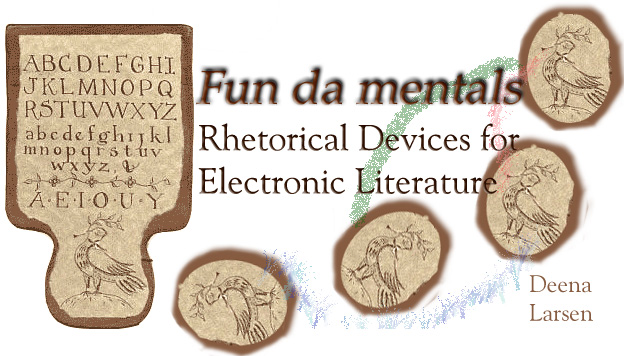
Electronic literature uses links, images, sound, navigation, as well as text to convey meaning. Electronic literature is ergodic, and thus it is up to the reader to piece together the materials as the reader goes through the work. Elit 101explains how these elements work to convey meaning and provides examples and exercises for each element.
Fun da mentals is a:
- Hornbook that can serve as an introduction to learning to read electronic literature. Just as students learn complex processes by mastering the basic elements first, students can quickly grasp the ideas behind these rhetorical devices. Use the Explanation portion of each Fundamental as a spring board for discussion.
- Reader that lists works that use these devices so readers to explore the devices in the context of a complete electronic literature work. While readers have changed dramatically from McGuffey's day, the concept is still the same--present students with real life examples to show the rhetorical devices in action. Use the Exploration portion of each Fundamental works to supplement a syllabus or to build a library of works.
- Coloring book that provides simple instructions for creating a short electronic literature piece. Just as students learn anatomy better by coloring in the lines, students can learn these rhetorical devices by instantiating a work through the exercises. These exercises are designed to be created in any authoring system (e.g., html, flash, storyspace, director) that allows navigation via clicking. These exercises should take about 5 - 20 hours for a student to create. These are good exercises for collaboration. Use the Exercise portion of each Fundamental as an assignment for learning how to use an electronic tool. Please send me your creations so that I can include them or link to them on this site.
- Prompter that gives writing exercises as a jumping off place to write a creative electronic work. Just as writers use prompts to get over writers block, students can use these exercises to help get over the terror of the blank page. Use the Exploration portion of each Fundamental to create paper works that mirror what an electronic work can do--this is especially useful for teaching electronic literature techniques without having to learn the software. Please send me photos or videos of your creations so I can include them or link to the on this site.
Rendering a piece and adding your own energy, style, and format is a powerful way to understand techniques in your bones. I designed this set of short, renderable elit pieces with these goals in mind:
- Introduce electronic literature principles and techniques. Each piece clearly demonstrates one technique in electronic literature.
- Show the power of electronic writing and show it fast. Make sure that people who have never seen elit can immediately grasp the possibilities. Show linking, sound, graphics, meaning, and double meanings within the first 30 seconds.
- Be open to collaboration—and yet have simple instructions so that people with widely varying skills can have fun collaborating. Furthermore, make it easy for distance collaboration—set the scene and let people play with the ideas that ensue.
- Be readily translatable—yet have a common and consistent meaning so that this is the “same” work translated into many languages—or a single language many times. Be readily readable to someone with a one or two year experience with the language (it is ok to have the dictionary in hand). I designed these pieces to be easily translatable (without sound or homophone puns or techniques that depend on particular morphemes in English). These pieces are also adaptable to other writing system formats (design elements can be turned vertical or horizontal and not impact the structure and meaning of the structure).
I hope I have succeeded in sparking some interests and flaming the exciting fires of what is possible.
(see the Serbo-Croatian language translation of the tool page as of 11/2012. Thank you Jovana).
Fun da mentals:
Links /
Images /
Sounds / Multiple voices /
Node paths /
Spatial placement/
Collage and layering / Fonts / Secrets /
Random /
Glossary / Tools
/ Teacher's Guide
